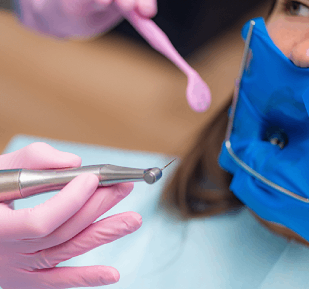
Restorative Dental Treatments
What Is Dental Caries?
Dental caries is caused entirely by the lack of individual oral care. Caries cause a lack of minerals in the hard tissues of the teeth within a certain period of time due to the microorganisms and food residues in the mouth. If caries that begin just below the outer surface of the tooth, progresses, it forms caries cavities. The integrity and robustness of the teeth are maintained with preventive treatment procedures applied before caries cavitation occurs, while after cavitation, intact tooth tissue is maximally protected, and restoration is carried out by removing the caries.
What Are The Symptoms Of Dental Caries?
Dental caries can often be seen as a black stain on the surface of the teeth. But in some cases, patients themselves may not be able to recognise dental caries. Therefore, dental check-ups should be performed at regular intervals. Symptoms of dental caries are:
- Bad breath,
- Toothache when consuming hot and cold foods and drinks and sugary foods,
- Ongoing pain with sensivity
How To Prevent Dental Caries?
Dental caries can be prevented via regular oral care and different methods. If you follow the oral care recommendations in this article regularly, it is possible to have healthy teeth.
- Regular dentist examination
- Healthy eating
- Brushing teeth for 2-3 minutes at least twice a day
- Low consumption of sugary foods
- Use of dental floss
What Is An Aesthetic (Composite) Filler?
To this day, different materials have been used for the treatment of dental caries along with developing technology. Since amalgam, among these materials, is aesthetically insufficient and causes discoloration on the teeth over time, it has been abandoned in modern dentistry today. Therefore, light-curing composite materials are preferred today both in terms of aesthetics and functioning.
Do Aesthetic Fillings Fall Off?
Composite fillings are mechanically attached to the tooth tissue, and composite fillings do not fall out when the treatment steps are applied correctly.
How Long Do Aesthetic Fillers Last?
The success of composite fillings may vary depending on the region they are applied in the mouth, the patient's oral care and the size of the filler applied. You can extend the life of your fillings by having a 6-month routine examination by your dentist, practicing proper oral hygiene and taking care of your teeth.
What Is Laminate Veneer?
In composite laminate veneer operation, the tooth structure of the patient is examined first, and then, if necessary, a very thin layer of abrasion is made from the tooth surface with a minimally invasive approach, and the teeth are restored with aesthetic composite materials. Thanks to this operation, the desired color and shape of teeth are obtained. Laminate veneers is a very curative procedure that makes the patient have an aersthetic and healthy smile.
What Is Preventive Dentistry?
Nowadays, since life expectancy is higher, teeth should remain in the mouth and be protected for a longer period of time. For this purpose, there are protective applications that should be done regardless of the age group. Examples of these are fluoride gel application, varnish application and fissure coating application. Our goal is to extend the life of teeth and keep them in the mouth for a longer period of time. Therefore, 6-month check-ups should not be neglected.
What Is Inlay / Onlay?
The main purpose of inlays and onlays is to restore a tooth that has lost a lot of substance. For this purpose, inlays and onlays are made of fiber-reinforced composite or ceramic. Inlay is a restoration that is performed when there is a solid tooth tissue around the filling that will be prepared, and onlay is perfomed when there is a lack of one or more walls of the tooth.
Why Do We Prefer Inlay And Onlay?
Usually, in teeth that have undergone root canal treatment or have advanced caries, the remaining tooth tissue is unsupported after cleaning the caries. Thisü process is more resistant to abrasion and chewing than fillings made directly in the mouth. In inlay and onlay, our goal is to restore the missing area by preparing the anatomical form and contact points on the model.
What Are The Advantages Of Porcelain Inlays And Onlays?
The material used is made of ceramic or fiber-reinforced composite.
It yields aesthetically successful results.
Inlays and onlays are resistant to the force of abrasion and chewing.
Natural tooth tissue is preserved as much as possible.
It is a long-lasting product if proper oral care is performed.














